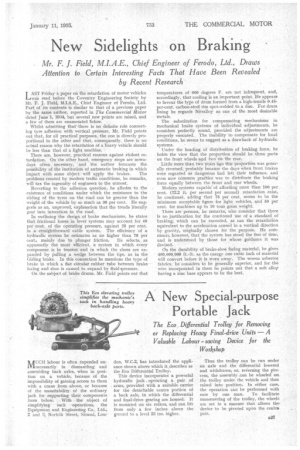New Sidelights on Braking
Page 55

If you've noticed an error in this article please click here to report it so we can fix it.
Mr. F. J. Field, Chief Engineer of Ferodo, Ltd., Draws Attention to Certain Interesting Facts That Have Been Revealed by Recent Research
LAST Friday a paper on the retardation of motor vehicles LA was read before the Coventry Engineering Society by Mr. F. J. Field, M.I.A.E., Chief Engineer of Ferodo, Ltd. Part of its contents is similar to that of a previous paper by the same author, reported in The Commercial Motor dated June 1, 1934, but several new points are raised, and a few of them are enumerated below.
Whilst admitting that' there is no definite rule connecting tyre adhesion with vertical pressure, Mr. Field points out that, for all practical purposes, the one is directly proportional to the other and that, consequently, there is no actual reason why the retardation of a heavy vehicle should be less than that of a light machine.
There are, however, practical reasons against Violent retardation. On the other hand, emergency stops are nowadays often necessary, and the author forecasts the possibility of the institu Hem of automatic braking in which impact with some object will apply the brakes. The problems created by modern traffic conditions, he remarks, will tax the ingenuity of engineers to the utmost.
Reverting to the adhesion question, he alludes to the existence of conditions under which the resistance to the sliding of the tyres on the road can be greater than the weight of the vehicle by so much as 30 per cent. He suggests as an, unproved, explanation that the treads literally gear into interstices in the road.
In outlining the design of brake mechanisms, he states that frictional losses in lever systems may account for 40 per cent. of the operating pressure, against 25 per cent. in a straightforward cable system. The efficiency of a hydraulic system he estimates as no higher than 78 per
cent., mainly due to plunger friction. He selects, as apparently the most efficient, a system in which, every component is in tension and in which the shoes are expanded by pulling a wedge between the tips, as in the Girling brake. In this connection he mentions the type of brake in which a flat circular rubber tube between brake facing and shoe is caused to expand by fluid Tressure.
On the subject of brake drums, Mr. Field points out that temperatures of 900 degrees F. are not infrequent, and, accordingly, that cooling is an important point. He appears to favour the type of drum formed from a high-tensile 0.45per-cent. carbon-steel rim spot-welded to a disc. For drum lining he regards Nitralloy as one of the most desirable metals.
The substitution for compensating mechanisms in mechanical brake systems of individual adjustments, he considers perfectly sound, provided the adjustments are properly executed. The inability to compensate for local conditions, he seems to suggest as a drawback of hydraulic systems.
Under the heading of distribution of braking force, he holds the view that the proportion should be three parts on the front wheels and two on the rear.
Little more than two years ago this proportion was generally reversed, probably because the days when front brakes were regarded as dangerous had left their influence, and even now common praaice was to distribute the braking force equally between the front and rear wheels.
Modern systems capableof affording more than 100 per cent. (32.2 ft. per second per second) retardation exist, he continues, adding that 75 per" cent. seems to be the minimum acceptable figure for light vehicles, and 50 per cent, for machines up to 10 tons gross weight.
1 here are persons, he remarks; who consider that there is no justification for the continued use of a standard of braking, which can be exceeded, as can the retardation equivalent to the acceleration caused in a vertical direction by gravitY, originally chosen for the purpose. He comments, however, that the system has stood the fest of time, and is understood by those for whose guidance it was devised. '
Cu the durability of brake-shoe facing material, he gives 460,000,000 ft-lb. as the energy one cubic inch of material will convert before it is worn away. The woven asbestos fabrics, he considers to be generally superior, and for the wire incorporated in them he points out that a soft alloy having a zinc base appears to be the best.




































































































